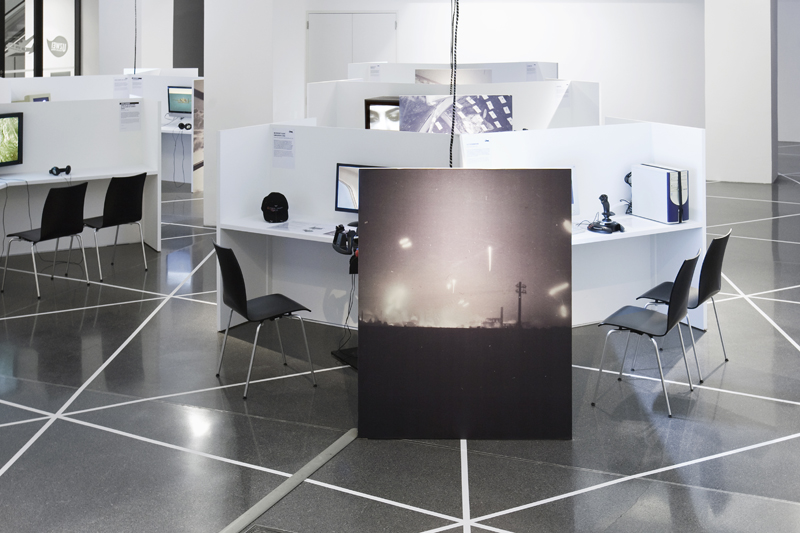BER-DTM-HNL...
The exhibition BER-DTM-HNL... presents characteristic examples for the history of flight simulators since the 1980s. This selection is augmented by a variety of different artistic positions that address the ideas of simulation, play, and flight. The flight simulators presented here are - as 'serious games' - a point of departure for an investigation into artworks that explore the “dream (and realities) of flying” in political, philosophical, or aesthetic ways. The architecture of the exhibition is a strong (but ironical) evocation of cubicles and internet cafés, mixed with a touch of high-tech and runway (the white grid taped on the floor).








The history of flight simulation dates back to the invention of airplanes. It became quickly evident that flying requires precise skills and that, in case of accident due to the lack of training from the pilot, this could be a fatal ending. If the first flight simulators where analog machines, the MIT started in 1946 to research on computers and flight simulation. After that date their conception followed the technical evolution from the computers: from very limited graphics in the 1970’s flight simulators have, today, a precise and accurate 3D rendering and are connected with Internet to collect real time informations about the weather.
In the video-game industry, flight simulators have a special status. If you don’t possess the basic knowledge necessary to pilot a plane, the game will usually end pretty brutally, a few meters after you took off. The satisfaction, here, is not in the immediacy of the achievement but in seriousness, complexity and accuracy of the simulation. And people, nowadays, have pleasure using hyper-realistic flight simulators at home to spend a few hours crossing a virtual atlantic.
« Amateur » flight simulation, « combat » flight simulation and « space » flight simulation are the three sub-genres from those softwares. If the first one is realistic, the second one gets closer to the idea of gaming (you shoot enemy planes and re-write the history of famous battles) while the last one takes us into science fiction. The exhibition presents a few historical games, between easy entertainment and absolute accuracy to the real flight. And if some softwares are clearly games, others are extremely realistic and they present us 30 years of history of simulation and technological evolution.
We already said it: flight simulators allow us to re-play the WWII, to learn how to crash a plane on a skyscraper or to imagine the future of flying to the Moon. Artists, of course, did quickly see the (politic and esthetic) potential of those softwares, their images and content. For instance Martin Dammann deals with the History of WWI & WWII through photographic archive, collecting images of aerial combats that only a trained eye can read. Closer to our epoch, Harun Farocki & Antje Ehmann reveals the connections between virtual gaming and real war while, before the events of 9/11, Johann Grimonprez told the linked history of terrorism and planes during the 20th Century. Last but not least, Simone Aaberg-Kærn is both in everyday life and her artistic practice: a pilot and an artist.
Showing side by side vintage and actual softwares with contemporary artworks that discuss the beauty, the political and philosophical implications of real and virtual flying, the exhibition presents a technological evolution, a reflection on the concept of simulation (real vs. virtual) and the strangeness of such an activity as flying with the help of a computer.
![]()
![]()
BER-DTM-HNL...
HMKV in Dortmunder U, Dortmund (Germany)
December 4, 2014 — January 11, 2015
Curated by Thibaut de Ruyter and Inke Arns
Exhibition architecture: Thibaut de Ruyter (with the assistance of Camille Rouaud)
Sofwares: Red Baron, 1980, Pilotwings, 1990 (Super-Nintendo), Microsoft Flight Simulator, 1982-today, Chuck Yeager’s Air Combat, 1991, FlightGear, 1997-today, IL-2 Sturmovik, 2001-today, Kerbal Space Program, 2011-today, War Thunder, 2012-today
supplied and supported by the Oldenburger Computer-Museum e.V.
Artists: Agnes Meyer-Brandis, Archive Martin Dammann, Antje Ehmann & Harun Farocki, Johan Grimonprez, Francis Hunger & Cornelia Friederike Müller, Simone Aaberg Kærn, and Joan Leandre

